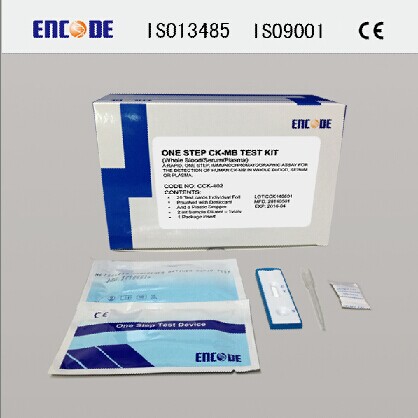INTENDED USE
The CK-MB Rapid Test Device (Whole Blood/Serum/Plasma) is a rapid chromatographic immunoassay for the qualitative detection of human CK-MB in whole blood, serum or plasma as an aid in the diagnosis of myocardial infarction (MI).
INTRODUCTION
Creatine Kinase MB (CK-MB) is an enzyme present in the cardiac muscle with a molecular weight of 87.0 kDa.1 Creatine Kinase is a dimeric molecule formed from two subunits designated as “M” and “B” which combine to form three different isoenzymes, CK-MM, CK-BB, and CK-MB. CK-MB is the isoenzyme of Creatine Kinase most involved in the metabolism of cardiac muscle tissue.2 The release of CK-MB into the blood following MI can be detected within 3-8 hours after the onset of symptoms. It peaks within 9 to 30 hours, and returns to baseline levels within 48 to 72 hours.3 CKMB is one of the most important cardiac markers and is widely recognized as the traditional marker for the diagnosis of MI.
The CK-MB Rapid Test Device (Whole Blood/Serum/Plasma) is a simple test that utilizes a combination of antiCK-MB antibody coated particles and capture reagent to detect CK-MB in whole blood, serum or plasma. The minimum detection level is 5 ng/mL.
KIT COMPONENTS
Materials Provided
1.Test devices
a.Droppers
b.Buffer
2.Package insert
PROCEDURE
Allow the test, specimen, buffer and/or controls to reach room temperature (15~30°C) prior to testing.
1.Bring the pouch to room temperature before opening it. Remove the test device from the sealed pouch and use it as soon as possible.
2.Place the test device on a clean and level surface.
For Serum or Plasma specimens:
Hold the dropper vertically and transfer 2 drops of serum or plasma (approximately 50 mL) to the specimen well (S) of the test device, then add 1 drop of buffer and start the timer.
For Venipuncture Whole Blood specimens:
Hold the dropper vertically and transfer 2 drops of venipuncture whole blood (approximately 50 mL) to the specimen well (S) of the test device, then add 1 drop of buffer and start the timer.
For Fingerstick Whole Blood specimens:
- To use a capillary tube: Fill the capillary tube and transfer approximately 50 mL of fingerstick whole blood specimen to the specimen well (S) of the test device, then add 1 drop of buffer and start the timer.
- To use hanging drops: Allow 2 hanging drops of fingerstick whole blood specimen (approximately 50 mL) to fall into the center of the specimen well (S) on the test device, then add 1 drop of buffer and start the timer.
3.Wait for the colored line(s) to appear. Read results at 10 minutes. Do not interpret results after 20 minutes.

INTERPRETATION OF RESULTS
(Please refer to the illustration above)
POSITIVE:* Two distinct colored lines appear. One colored line should be in the control line region (C) and another apparent colored line should be in the test line region (T).
*NOTE: The intensity of the color in the test line region (T) will vary depending on the concentration of CK-MB present in the specimen. Therefore, any shade of color in the test line region (T) should be considered positive.
NEGATIVE: One colored line appears in the control line region (C). No line appears in the test line region (T).
INVALID: Control line (C) fails to appear. Insufficient specimen volume or incorrect procedural techniques are the most likely reasons for control line failure. Review the procedure and repeat the test with a new test. If the problem persists, discontinue using the test kit immediately and contact your local distributor.
bio-equip.cn





